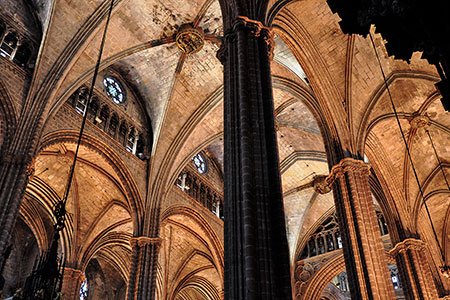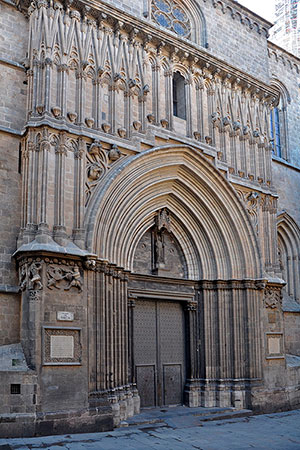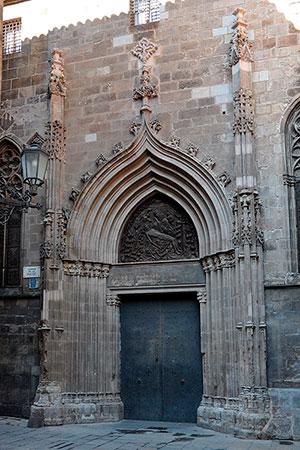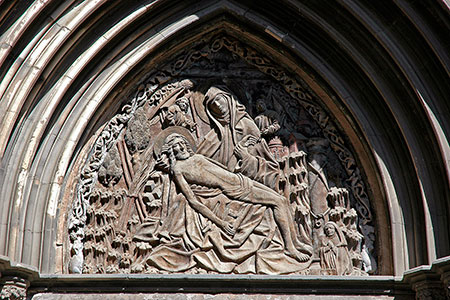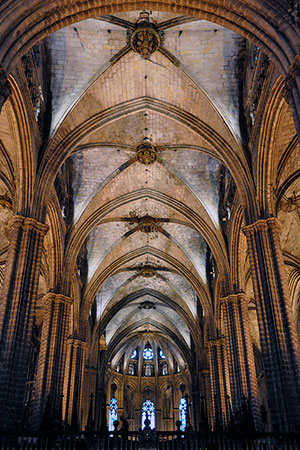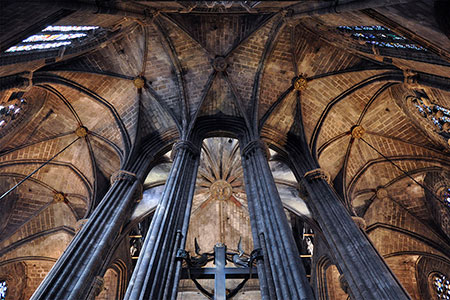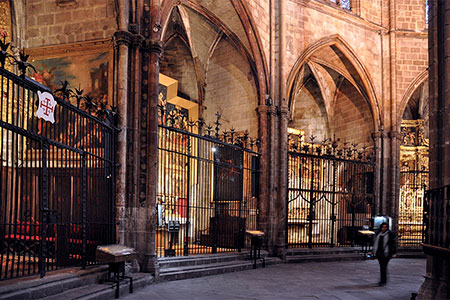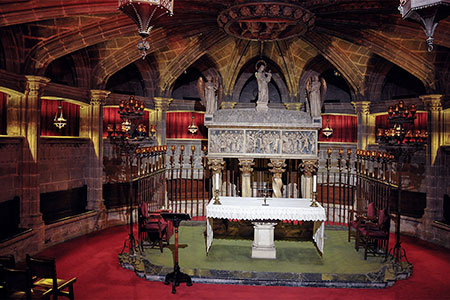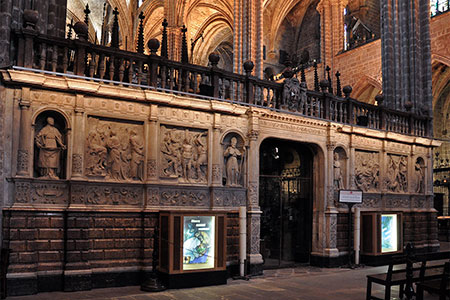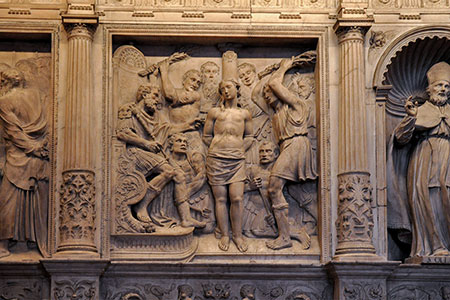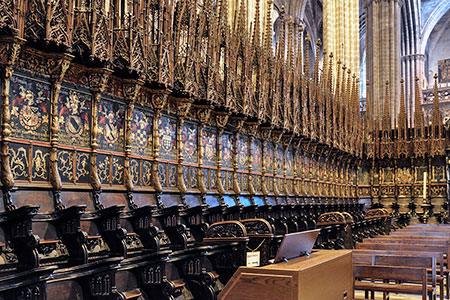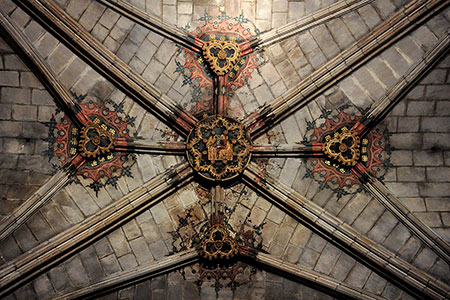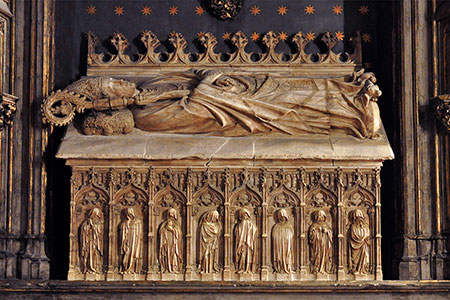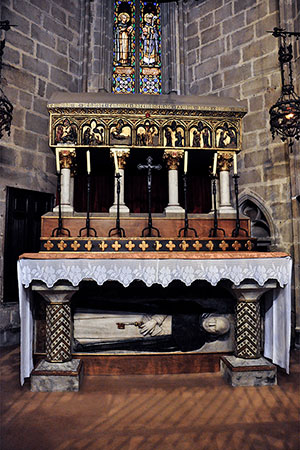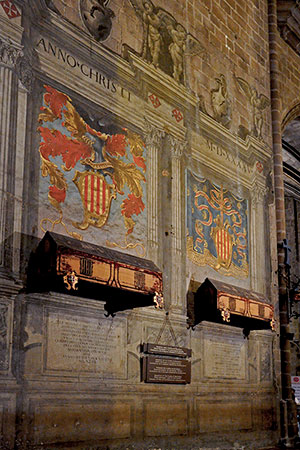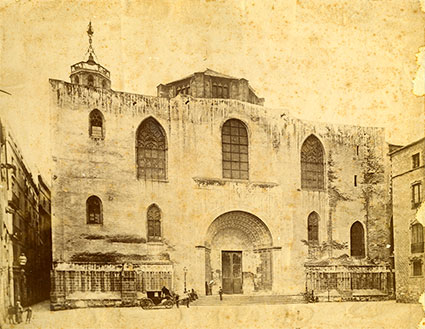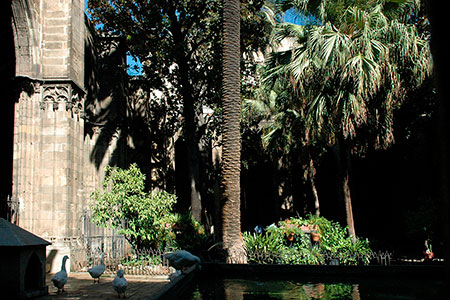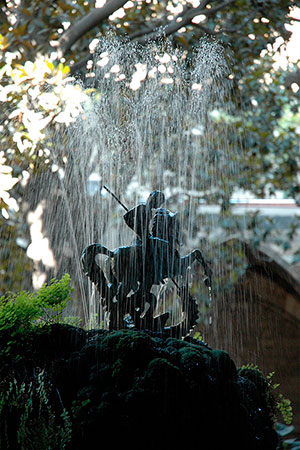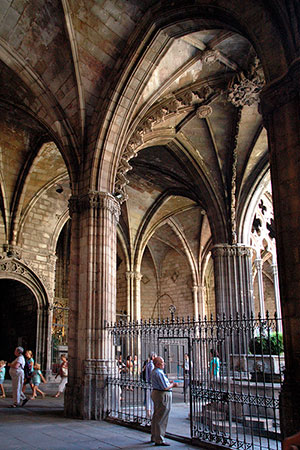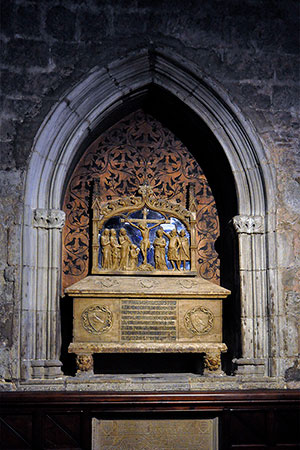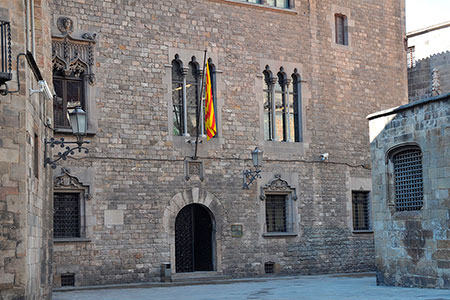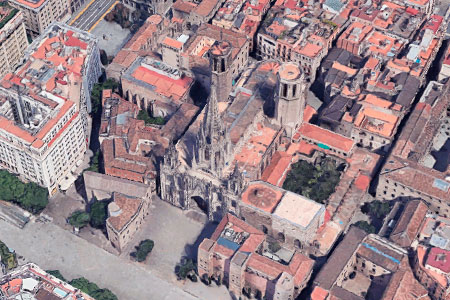Canorny of the Cathedral of Barcelona
Santa Creu i Santa Eulàlia de Barcelona / Domus Capitulo Barchinonae
There is evidence of the existence of a cathedral in Barcelona since ancient times. It is known that a certain Praetextatus, bishop of Barcelona, attended a council in 343. Surely there must have been a cathedral seat then, but the first one of which remains have been found dates to the 5th century. In a council held in Barcelona in 576, it is mentioned that the cathedral was dedicated to the Santa Creu (Holy Cross).
In the Visigothic period, the Christian population of Barcelona was divided into two communities, the Arian and the Catholic, the latter having its headquarters in the church of Sants Just i Pastor. Between 717 and 801 the seat of Barcelona was under Muslim occupation and the cathedral was most probably converted into a mosque. In the time of Bishop Frodoí it was restored, both physically and spiritually, and in this sense the bishop put an end to Mozarabic worship and imposed Roman or Carolingian worship. In 877 the relics of Saint Eulalia were solemnly transferred to the cathedral where they are still venerated. The capture of Barcelona by Almanzor in 985 destroyed the building and forced it to be rebuilt.
In Barcelona, as in the other existing Visigothic dioceses, there was probably some kind of canonical community around the cathedral, but there are no specific reports. It was after the recovery of the territory from Islam that we find references to a cathedral canonical community, which differed from the other monastic communities. Life was probably governed by the canonical rule adopted in Aachen, but the very nature of the community, which was not very cohesive and was based on members of wealthy houses, gave way to situations of spiritual relaxation which periodically tried to be redressed.
A privilege granted by Louis the Stammerer in 878, in the time of Bishop Frodoí, restored the canonical status of Barcelona Cathedral. In 944, Count Sunyer helped the community financially to build a new building. The canonry was also restored and endowed in 1009 by bishop Aeci. It was always an Aquisgranese canonry with very relaxed customs; it was not reformed to adopt the Rule of Saint Augustine or that of Saint Rufus, despite the relationship that Oleguer, canon of the Cathedral, after the canonry of Sant Adrià and later abbot of Saint-Ruf of Avignon, had with this canonical current. In 1299, the papal legate reordered the canonry again and established the number of canons at forty. In 1592 it was secularized.
The construction of the Romanesque cathedral was completed in the time of Ramon Berenguer I, in 1058, at least in its essential parts, it was a building with three naves, with a little apparent transept and headed by three semicircular apses. Its situation was the same as that of the present building. Over the years, the church became too small, at the end of the 13th century, it was decided to enlarge the building, respecting the Romanesque cathedral as much as possible and interfering as little as possible in the life of the place; the canons were obliged to use the building under construction for their ceremonies. The work began in 1298, and the result was a building that extended the old cathedral, whose stones were used to build the new one. The neo-Gothic façade was erected at the end of the 19th century and beginning of the 20th century.
The canons occupied the buildings that are now known as the Cases de la Canonja and Pia Almoina, an institution that was dedicated to feeding the poor, a function that was formerly carried out in the refectory of the canonical community, probably located around the old cloister. Between the cathedral and the Palau de la Generalitat are the Cases dels Canonges, a group of buildings that began to be erected when the canonical community was secularized and began to live in private residences. The neo-Gothic modifications and restorations have altered the ensemble.
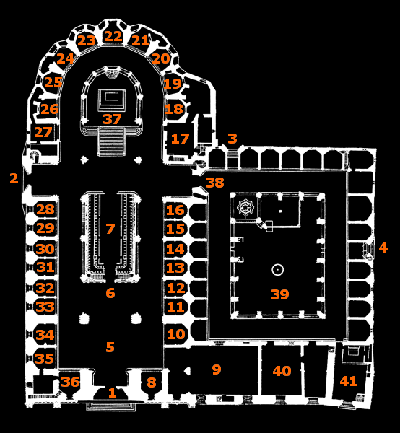
Detailed description ↗
- AINAUD DE LASARTE, Joan; MUNDÓ, Anscari M. (1997). Els vitralls de la catedral de Barcelona i del monestir de Pedralbes. Barcelona: Institut d’Estudis Catalans
- BASSEGODA, Joan (1995). Els treballs i les hores a la Catedral de Barcelona. Barcelona: R. A. Belles Arts de Barcelona
- BELTRÁN DE HEREDIA, Júlia (2005). La topografia cristiana del quadrant nord-est de "Barcino". El conjunt episcopal de Barcelona. Quaderns d'Arqueologia i Història de la Ciutat de Barcelona, núm. 1
- BELTRÁN DE HEREDIA, Júlia (2015). Barcelona a l’antiguitat tardana. El cristianisme, els visigots i la ciutat. Museu d’Història de Barcelona. Ajuntament de Barcelona
- BELTRÁN DE HEREDIA, Júlia; BONNET, Charles (1999). Conjunt episcopal de Barcelona. Del Romà al Romànic. Barcelona: Enciclopèdia Catalana
- BELTRÁN DE HEREDIA, Júlia; LORÉS, Immaculada (2005). La catedral romànica de Barcelona: revisió de les dades arqueològiques i de l'escultura. Quaderns d'Arqueologia i Història de la Ciutat de Barcelona, núm. 1
- BELTRÁN DE HEREDIA, Júlia; NICOLAU, Antoni (1999). Topografia dels espais de poder a l’època carolíngia. El conjunt episcopal i la residència comtal. Catalunya a l’època carolíngia. Art i cultura abans del romànic (segles IX i X). Barcelona: MNAC
- BONNET, Charles; BELTRÁN DE HEREDIA, Julia (2000). El primer grupo episcopal de Barcelona. Memorias de la Real Academia de Buenas Letras de Barcelona, vol. 25
- DURAN SANPERE, Agustí (1952). La catedral de Barcelona. Barcelona: Aymá
- FELIU, Gaspar (2021). La canònica de Barcelona, fins a la consagració de la catedral romànica. La catedral romànica de Barcelona. Girona: Documenta Universitaria
- FLOREZ, Henrique (1775). España Sagrada. Vol. XXIX. Santa Iglesia de Barcelona. Madrid: A. de Sancha
- FONT Y CARRERAS, Augusto (1891). La Catedral de Barcelona. Barcelona: A. Arquitectos de Cataluña
- GAVÍN, Josep M. (1993). Inventari d'esglésies. Vol. 26. Barcelonès II (Barcelona Capital I). Barcelona: Arxiu Gavín
- GUDIOL. Josep; ALCOLEA, Santiago (1987). Pintura gòtica catalana. Barcelona: Ed. Polígrafa
- JARDÍ ANGUERA, Montserrat (2020). La galeria de llevant del claustre de la catedral de Barcelona. Summa. Revista de Cultures Medievals, núm. 16
- VERGÈS, Martí, VINYOLES, M. Teresa (1992). Catalunya romànica. Vol. XX El Barcelonès, el Baix Llobregat, el Maresme. Barcelona; Enciclopèdia Catalana
- VILLANUEVA, Jaime (1851). Viage literario a las iglesias de España. Vols. XVII i XVIII. Viage a Lérida y Barcelona. Madrid: Imprenta de la Real Academia de la Historia
- Enllaç ↗ : Cathedral of Barcelona


